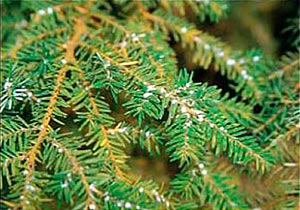Yale graduate student Nathan Havill was studying Asian hemlocks to learn why they can resist the hemlock wooly adelgid (HWA) while the Eastern hemlock (Tsuga canadensis) cannot. In the process, he studied some hemlocks growing at the Arnold Arboretum in Massachusetts, which were presumably southern Japanese hemlocks.
He discovered that the DNA of those hemlocks did not match that of any known species. An investigation showed that the Arnold Arboretum acquired the seeds in 1983 and that they came from Ulleungdo, a small island off the South Korean coast.
In 2008, Arnold biologist Peter Del Tredici traveled to Ulleungdo himself to gather more specimens, which he gave to Garth Homan, a botanist at the University of Maine. Homan found that some of the tree’s DNA was much like the southern Japanese hemlock, while other parts of the DNA more closely resembled that of a different Japanese species. Plus, the Ulleungdo tree had different needles and cones, and flushed new leaves several weeks earlier than the others.
After analyzing these and many other differences, the team announced a new hemlock species: Tsuga ulleungensis, the first new temperate conifer since 2002.
Scientists and others who hope to restore the devastated American hemlock forest are excited. However, since the tree is both rare and endangered, it will likely be a long process for all involved. Breeding work could produce trees that are mostly native but also adelgid resistant.
Excerpted from The Coniferite, Newsletter of the American Conifer Society Central Region.



